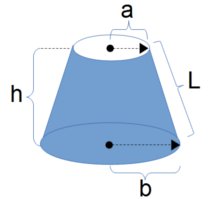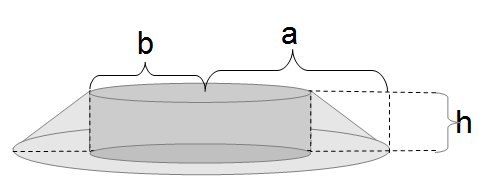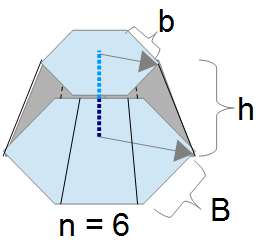Frustum
Tags | |
UUID | af00b42f-3521-11e4-b7aa-bc764e2038f2 |
The Frustum Calculator provides equations to calculate volume, mass, and surface area of common frustums  Cone frustum , including cones, bottles, pyramids, and cored cones. A frustum is a section of a solid that is produced by "cutting" it between two parallel planes.
Cone frustum , including cones, bottles, pyramids, and cored cones. A frustum is a section of a solid that is produced by "cutting" it between two parallel planes. Cored Frustum (aka chamfer)
Cored Frustum (aka chamfer)
Description
The Frustum calculator provides equations related to Frustums (see definition below). The equations include:
- Volume: The Volume tab of the calculator provides calculations of total volume from given dimensions (see diagrams).
- Surface Area: The Surface Area tab provides calculations of surface area, some including the bases (top and bottom) and some not.
 Frustum of a polygon pyramid
Frustum of a polygon pyramid - Mass: The Mass tab provides calculations of total volume given input dimensions and a specified mean density. The calculator button labeled "Common Mean Densities" offers numerous mean densities of common materials such as iron, air, sea water, and concrete which may be used as input to the mass equations.
(Common Mean Densities)For the mass equations, one can use the common mean densities formula to look up the mean density of common substances and then use the resulting value as input to the mass equation. The Mean Density Table Lookup button provides the mean density of hundreds (650+) of substances from gases, to metals, woods, foods, liquids and much more. The results are given in which is the default input units for the mass calculation.
The result of the mass equation can then be used in the equations for the moments of inertia.
Frustum
In geometry, a frustum (plural: frusta or frustums) is the portion of a solid (normally a cone or pyramid) that lies between two parallel planes cutting it.
The term is commonly used in computer graphics to describe the three-dimensional region which is visible on the screen, the "viewing frustum", which is formed by a clipped pyramid; in particular, frustum culling is a method of hidden surface determination.
In the aerospace industry, frustum is the common term for the fairing between two stages of a multistage rocket (such as the Saturn V), which is shaped like a truncated cone.
In geology, the caldera of a volcano can be approximated as an inverted conic frustum. The volume of a bucket can also be calculated as an inverted conic frustum. By combining a frustum with a cylinder, one can calculate the metrics of a bottle.
 Conic frustum on top of cylinder (aka bottle)
Conic frustum on top of cylinder (aka bottle)
See Also
- Cone Calculator - Equations for cones
- Cylinder Calculator - Equations for cylinders
- Sphere Calculator - Equations related to spheres.
- Circle Calculator - Equations related to circles
- Ellipse Calculator - Equations related to ellipses
- Geometer (3D) - Equations related to various shapes in 3D
- Frustum - Equations related to the frustums of various objects
- Moments of Inertia - Equations related to the Moments of Inertia of different shapes about different axes.
References
- Wikipedia - http://en.wikipedia.org/wiki/Frustum
Equations and Data Items
- Comments
- Attachments
- Stats
No comments |
